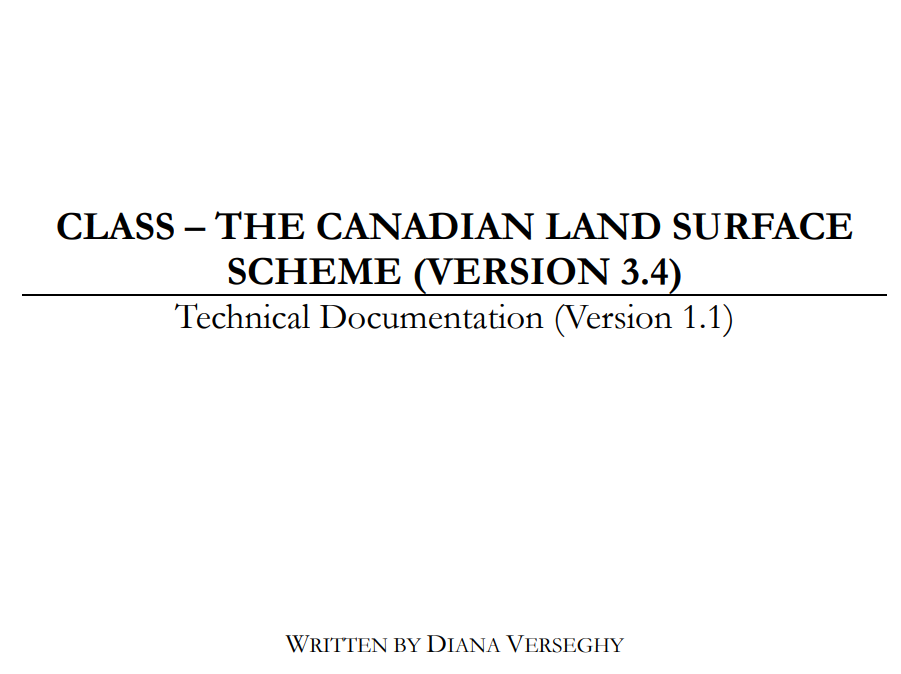Quoted from: CLASS – THE CANADIAN LAND SURFACE SCHEME (VERSION 3.4) Technical Documentation (Version 1.1). http://www.usask.ca/ip3/download/CLASS_v3_4_Documentation_v1_1.pdf
The Canadian Land Surface Scheme, CLASS, was originally developed for use with the Canadian Global Climate Model or GCM (Verseghy, 1991; Verseghy et al., 1993). This documentation describes version 3.4 of CLASS, which was released in April of 2008. The table at the end of this overview summarizes the development of CLASS from the late 1980’s to the present.
The basic function of CLASS is to integrate the energy and water balances of the land surface forward in time from an initial starting point, making use of atmospheric forcing data to drive the simulation. When CLASS is run in coupled mode with an atmospheric model, the forcing data are passed to it at each time step from the parallel atmospheric model simulation. CLASS then produces surface parameters such as albedo and surface radiative and turbulent fluxes, which are in turn passed back to the atmospheric model. CLASS can also be run in uncoupled or offline mode, with forcing data derived from a separate atmospheric model run or from field measurements, and its output fluxes and the values of its prognostic variables can then be validated against measured values. Version 3.4 includes an offline driver which can be used for this purpose.
CLASS models separately the energy and water balances of the soil, snow, and vegetation canopy if present (see the diagram below). The basic prognostic variables consist of the temperatures and the liquid and frozen moisture contents of the soil layers; the mass, temperature, density and albedo of the snow pack if present; the temperature and intercepted rain and snow on the vegetation canopy; the temperature and depth of ponded water on the soil surface; and an empirical vegetation growth index. These variables must be initialized, and a set of soil parameters describing the soil and vegetation present on the modelled area must be assigned values, at the beginning of the simulation (see the section on “Data Requirements”).
At each time step, CLASS calculates the bulk characteristics of the vegetation canopy on the basis of the vegetation types present over the modelled area. In a pre-processing step, the vegetation types present are assigned background values of parameters such as albedo, roughness length, annual maximum and minimum plant area index, rooting depth and so on (see the section on “Data Requirements”). These values are then aggregated over four main vegetation categories identified by CLASS: needleleaf trees, broadleaf trees, crops, and grass (i.e. short vegetation). The physiological characteristics of the vegetation in each category are determined at the current time step using the aggregated background parameters and assumed annual or diurnal variation functions. These physiological characteristics are then aggregated to produce the bulk canopy characteristics for the current time step.

In performing the surface flux calculations the surface is divided into up to four subareas: bare soil, vegetation over soil, snow over bare soil, and vegetation over snow. The fractional snow coverage is determined using the concept of a threshold snow depth. If the calculated snow depth is less than this value, the snow depth is set to the threshold value and the fractional snow cover is calculated on the basis of conservation of snow mass. The fluxes are calculated for each of the four subareas, and these and the prognostic variables are then areally averaged before being passed back to the atmospheric model.
Originally CLASS performed only one set of these calculations for each grid cell of the model domain. In more recent versions, a “mosaic” option has been added to handle sub-grid scale heterogeneity more effectively, in which each grid cell is in turn divided into a user-specified number of mosaic “tiles”, and the CLASS calculations are performed over each. The prognostic variables are kept separate for each of the tiles of the mosaic between time steps.
The section on the CLASS offline driver, RUNCLASS, provides information on how a CLASS run is typically performed, from assigning the background and initial values of variables, through calling the high-level CLASS subroutines, to calculating values of diagnostic and output variables. A gather-scatter operation is included in the driver, mimicking the practice in atmospheric models of “gathering” land surface points on latitude circles onto long vectors prior to the calculations, for improved computational efficiency on vector supercomputers. For CLASS, the mosaic tiles on each of the modelled grid cells are “gathered” onto long arrays of mosaic tiles prior to calling the CLASS subroutines (thus collapsing the first two dimensions of the arrays into one), and subsequently “scattered” back onto the grid cells before performing the diagnostic averaging calculations.
The sections following the one that describes the driver provide detailed descriptions first of the common block and other preliminary routines that are called before the run is launched, and then of the pre- and post-processing routines that are called at the beginning and end of each time step. The next three sections detail the three main CLASS subroutines together with the auxiliary subroutines that they call: CLASSA, which handles the calculation of the albedos and other surface parameters; CLASST, which addresses the evaluation of the surface energy balance and related variables; and CLASSW, which performs the surface water balance calculations and the re-aggregation of the prognostic variables. The sub-section on each subroutine contains a dictionary of the variables passed into and out of it, with units.








